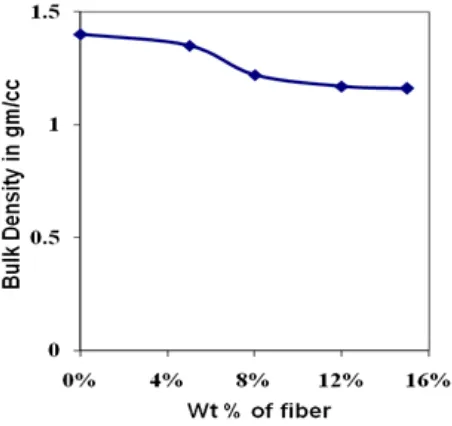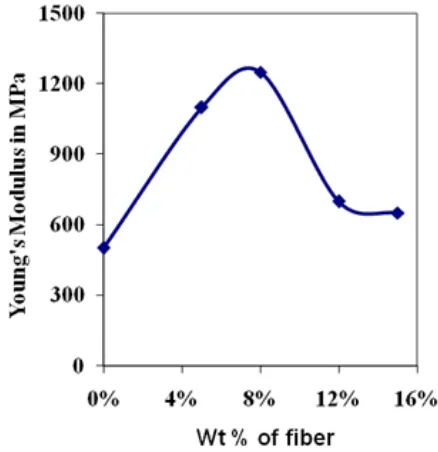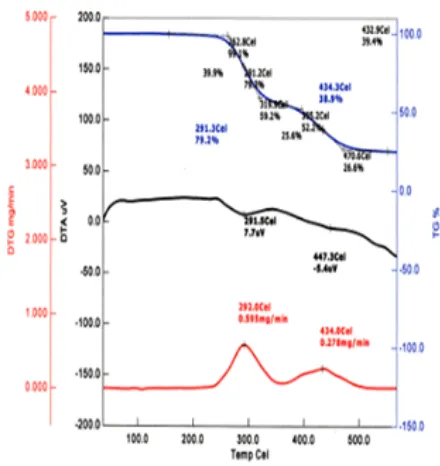Investigation of Physical and Mechanical Properties of
Bamboo Fiber and PVC Foam Sheet Composites
Humayun Kabir
1,*, Md. Abdul
Gafur
2, Farid Ahmed
1, Farhana Begum
1, Md. Rakibul Qadir
21
Department of Physics, Jahangirnagar University, Savar, Dhaka 1342, Bangladesh
2
Pilot Plant & Process Development Center of Bangladesh Council of Scientific & Industrial Research (BCSIR), Dhaka 1205, Bangladesh
Abstract
The bamboo fiber and PVC foam sheet composites were developed via hot compression molding process. Different percentages (0%, 5%, 8%, 12% and 15%) of bamboo fibers were introduced into the PVC foam sheets. Various physical and mechanical properties of the composites have been investigated. Bulk density decreases with the increase of percentage of fibers introduction to the PVC sheets. Percentage of water absorption was found to increases with the soaking time for all the samples. Mechanical properties e.g., tensile strength, flexural stress, flexural strain and tangent modulus of the composites are observed to be increases while the tensile strain decreases with the subsequent fiber addition to the PVC sheets. At the same time, the Young’s modulus found to be increased up to 10% of the bamboo fibers introduction and then decreases with the further enhance of the fiber content. The maximum Young’s modulus (1250 MPa) was found for 8 % of bamboo fiber to the PVC composite sheets. Thermal analysis confirmed the better thermal stability of bamboo fiber PVC composites.Keywords
Bamboo fiber, PVC foam, Composites, Bulk density, Tensile strength and Tangent modulus1. Introduction
Today in the age of environmental pollution, it needs every material should be environmental friendly. So it is essential to develop and use biodegradable materials. When it is thought about biodegradable composites, natural fiber is come first in consideration. A large number of natural fibers are locally available. It is easy to collect and to store. Use of these fibers as reinforced materials increase biodegradability, reduces cost and decreases pollution of environment and hazard. To increase the use of a fiber, it is important to find its composites, molecular weight, tensile strength, etc [1-3]. The use of natural fibers, derived from annually renewable source, as reinforcing fibers in both thermoplastic and thermosetting matrix composites provides positive benefits with respect to ultimate disposability and ray materials utilization. The composite technology of a polymeric matrix reinforced with man-made fibers such as glass, Kevlar,
are useful for many structural applications, the ultimate tensile strength of some BFRP composites is more or less equal to the ultimate tensile strength of mild steel, while their density is approximately one eighth of the density of mild steel. He also observed that the mechanical behaviour of these composites is similar to other commonly used composites such as Glass fibre reinforced plastics. The alkali treated bamboo fiber-reinforced plastic (BFRP) composites were developed by P. Kushwaha et al. [22]. They reported that the improvements in tensile strength and flexural strength were higher by 55.15 and 43.92%, respectively, for composites with epoxy matrix and in the case of alkali-treated composites with polyester matrix, the tensile strength and flexural strength were higher by 69 and 59%, respectively. A.V. R. Prasad et al. [23] reported the experiments of tensile and flexural tests carried out on composites made by reinforcing jowar as a new natural fibre into polyester resin matrix. It is concluded that the mean tensile modulus of jowar fibre composite is higher than those of sisal and bamboo fibre composites at highest volume fraction of fibre. The flexural modulus of jowar fibre composite is much higher than those of sisal and bamboo fibre composites. K. Okubo et al. [24] developed bamboo-based polymer composites for ecological purposes (Eco-composites). The experimental results showed that the bamboo fibers (bundles) had a sufficient specific strength, which is equivalent to that of conventional glass fibers. The tensile strength and modulus of PP based composites using steam-exploded fibers increased about 15 and 30%, respectively, due to well impregnation and the reduction of the number of voids, compared to the composite using fibers that are mechanically extracted. G. Han et al. [25] have fabricated the high density polyethylene (HDPE)/bamboo composites with different nanoclay and maleated polyethylene (MAPE) contents by melt compounding and found that the tensile strength, bending modulus and strength were improved with the use of MAPE in HDPE/bamboo fiber composites.
In the present study, our attention has been given on the improvement of physical and elastic properties of Bamboo Fiber and PVC Foam Sheet Composites with increase in wt% of fiber and length of soaking time.
2. Materials and Methods
The PVC foam sheet was cut into 5 inch × 5 inch size by using paper cutting machine. The bamboo fibers were 1 mm in thickness and were cut into the length of 5 inch. The PVC sheet was weighted using an electronic balance. Some amounts like 5%, 8%, 12%, 14% bamboo fiber mate was taken to make specimen. The compression –molding process was used to produce article from polymer materials. Here polymeric materials and fiber are subjected to heat (1800) and pressure (50 KN) in a single stroke. The cooling was done by tape water. To measure bulk density, the weight and volume of each specimen was measured and their ratio gives
the bulk density. To measure water absorption, the specimen was prepared according to the ASTM Destination: C67-91 [26]. The test specimen was 26-29 mm in length, 23.5 to 25.5 mm in width and 7-8 mm in height. Hounsfield universal testingmachine (UTM) 10 KN (H10KS) was used for test of tensile and flexural strength [27]; compression and shear properties of materials. An electrical balance is used for measurement of weight of the sample. Thermal properties of the samples were monitored by a coupled Differential Thermal Analyzer (DTA) and Thermo Gravimetric Analyzer (TGA). Composites were taken using a computer controlled to an EXSTAR 6000 STATION, Seiko Instrument Inc. Japan. The TGA/DTA module uses a horizontal system balance machine. The specifications of the instruments were: heating rate: 0.1 K/min. to 100.00 K/min, TGA measuring range:
±200 mg (0.2μg), DTA measuring range: ± 100μV (0.06 μV),
Gas flow: 1000m/min.
3. Results and Discussion
Physical PropertiesFig. 1 represents the bulk density of bamboo fiber/PVC composites. From figure it is clear that bulk density decreases as the percentage of fiber increases. This is expected because the density of bamboo fiber is smaller than that of PVC foam sheet. Bulk density is larger for glass fiber and PVC foam sheet composites [28].
Figure 1. Bulk density of bamboo fiber & PVC foam sheet composites.
Figure 2. Effect of water absorption on 5%, 8%, 12% and 15% bamboo fiber and PVC foam sheet composites.
Mechanical Properties
Fig. 3 shows the study of tensile strength of bamboo fiber with the reinforcement of PVC foam sheet. It is seen that tensile strength increases with the increase of percentage of fiber content. The increase in rate is higher after 10% than that of below 10%. Fig. 4 represents the effect of weight percentage (wt %) on tensile strain of bamboo fiber with reinforcement of PVC foam sheet. It reveals that after 5%, the tensile strain decreases as the percentage of fiber increases [23-25, 30-31].
Figure 3. Tensile strength of bamboo fiber mat & PVC foam sheet composites.
Figure 4. Variation of tensile strain with different wt% of bamboo fiber mat & PVC foam sheet composites.
Fig. 5 presents the effect on Young’s modulus of different composites. It is seen that Young’s modulus and hence stiffness increases with increase of fiber addition up to certain percentage (8 %) of addition and after that it decreases. This is because up to 8% the fiber and polymer are well distributed [25]. The effect of fiber addition on flexural strength of bamboo fiber & PVC foam sheet composites is shown in Fig. 7. From graph it is evident that flexural strength increases with increase in fiber addition. For 0% fiber the polymer strength was obtained 12.15 MPa.
Figure 6. Flexural strength of bamboo fiber & PVC foam sheet composites.
Figure 7. Flexural strain of bamboo fiber & PVC foam sheet composites.
Up to 5%, the flexural strength increases slowly. The reason is that at the time of reinforcement of fiber with PVC foam sheet, there was some regions were there were no fibers. After 5% fiber addition both fiber and matrix bear the load and make resistance to slip as in the case of age hardening of metals. The fibers are finely distributed and the interfacial bonding between the fiber and matrix is high. Fig. 7 represents the effect of fiber addition on flexural strain of bamboo fiber & PVC foam sheet composites. It reveals that flexural strain of fabricated product increases with increase of fiber addition [25]. The variation of tangent modulus of different fabricated composites is shown in Fig.8. From graph it is seen that the tangent modulus increases slowly up to 5% and after that it increases very sharply [29]. Fig. 9 shows the TG, DTA and DTG curves for PVC foam. The
major degradation occurs in two stages. The first stage is called dechlorination and the second stage is called depolymerisation. In dechlorination, the total mass loss occurred 39.9% but in depolymerisation, that of occurred 25.6% remaining 26.6% residue. DTA yields the two endothermic peaks at 291.5°C and 447.3°C respectively. The first one is due to the melting and the second one is due to the degradation of PVC.
Figure 8. Tangent modulus of bamboo fiber & PVC foam sheet composites.
Figure 9. TG, DTA and DTG curve for PVC foam sheet
DTA and DTG curves for bamboo fiber & PVC foam sheet composite. The TG curve reveals that an initial 1.5% losses due to moisture content of fiber. The major degradation occurs at two steps .The lighter substances remove initially and then the heavier material. The first stage is called Dechlorination and the second stage is called Depolymerisation. In dechlorination, the total mass less occurred 41.7%. But in depolymerisation that of occurred 22.7% remaining 24.6% residue. DTA yields the two endothermic peaks at 82.2°C and 285.9°C respectively. The first one is due to the melting and the second one is due to the degradation of composite. The DTG curve shows the two peaks at 287.1°C that indicates there is two steps degradation, the initial one is due to elimination of lighter materials and moisture. The maximum degradation rate was obtained at 287.1°C at the rate of 1.33 mg/min.
Figure 10. TG, DTA and DIG for bamboo fiber & PVC foam sheet composites
4. Conclusions
The bulk density decreases with the percentage of fiber addition for all composites. The water absorption increases with increase of the percentage of fiber addition as well as soaking time for all composites. The tensile strength increases and tensile strain decreases with percentage of fiber content. The highest tensile strength was found in the 15 % fiber addition composites. Young’s modulus is largest for 8 % bamboo fiber content composite. Flexural strength rises rapidly with percentage of fiber addition and 15 % fiber content composite shows the maximum value, about 110 MPa. The flexural strain increases from 0 % to 5 % and after that it is almost independent with percentage of bamboo fiber content. The tangent modulus is about 2000 MPa for 0 % and 5 % bamboo fiber content composites. The tangent modulus
bumps up from 5 % to 8 % fiber addition composites and the greatest amount of tangent modulus is found to 15 % fiber content composites. Better thermal stability was found for bamboo fiber PVC composites .
REFERENCES
[1] A. Jahan, M. M. Rahman, H. Kabir, M. A. Kabir, F. Ahmed, M. A. Hossain, M. A. Gafur, “Comparative Study of Physical And Elastic Properties of Jute And Glass Fiber Reinforced LDPE Composites”, International Journal of Scientific and Technology Research, Vol. 1, No. 10, 68-72, 2012.
[2] A. Fardausy, M. A. Kabir, H. Kabir, M. M. Rahman, K. Begam, F. Ahmed, M. A. Hossain, M. A. Gafur, “Study of Physical, Mechanical and Thermal Properties of Unidirectional Jute Fiber Reinforced PVC Film Composites” International Journal of Advanced Research in Engineering and Technology, Vol. 3, No. 2, 267-274, 2012.
[3] S. K. Das, J. M. M. Islam, M. Hasan, H. Kabir, M. A. Gafur, E. Hoque, M. A. Khan, “Development of Electrically Conductive Nanocrystalline Thin Film for Optoelectronic Applications”, International Letters of Chemistry, Physics and Astronomy, Vol. 10, No. 1, 90-101, 2013.
[4] S. Afroze, H. Kabir, M .M. Rahman, M. A. Kabir, F. Ahmed, M. A. Hossain, M. A. Gafur, “Elastic and Electrical Properties of Graphite and Talc Filler Reinforced Polypropylene (PP) Composites”, International Journal of Basic & Applied Sciences IJBAS-IJENS, Vol. 12, No. 5, 13-16, 2012.
[5] A. Jahan, M. M. Rahman, H. Kabir, M. A. Kabir, F. Ahmed, M. A. Hossain, M. A. Gafur, “Optical, Electrical and Thermal Properties of Jute and Glass Fiber Reinforced LDPE Composites”, International Journal of Scientific and Technology Research, Vol. 1, No. 10, 482-490, 2012.
[6] S. Afroze, M .M. Rahman, H. Kabir, M. A. Kabir, F. Ahmed, M. A. Hossain, M. A. Gafur, “Physical, Optical and Thermal Properties of Graphite and Talc Filler Reinforced Polypropylene (PP) Composites”, International Journal of Advanced Scientific and Technical research, Vol. 5, No. 2, 40-49, 2012.
[7] M. S. Mina, H. Kabir, M. M. Rahman, M. A. Kabir, M. Rahaman, M. S. Bashar, M. S. Islam, A. Sharmin, F. Ahmed, “Optical and Morphological Characterization of BaSe Thin Films Synthesized via Chemical Bath Deposition ”, IOSR Journal of Applied Physics, Vol. 4, No. 5, 30-35, 2013.
[8] B. Neher, M. M. R. Bhuiyan, H. Kabir, M. R. Qadir, M. A. Gafur, F. Ahmed, “Study of Mechanical and Physical Properties of Palm Fiber Reinforced Acrylonitrile Butadiene Styrene Composite”, Journal of Materials Sciences and Applications, Vol. 5, 39-45, 2014.
[9] H.P.S. Abdul Khalil, I.U.H. Bhat, M. Jawaid, A. Zaidon, D. Hermawan, Y.S. Hadi, “Bamboo fibre reinforced biocomposites: A review”, Materials and Design, Vol. 42, 353-368, 2012.
30-34, 2012.
[11] A.K. Bledzki, J. Gassan, “Composites Reinforced With Cellulose Based Fibres”, Progress in Polymer Science, Vol. 24, No. 2, 221-274, 1999.
[12] R. Khullar, V. K. Varshney, S. Naithani, P. L. Soni, “Grafting of acrylonitrile onto cellulosic material derived from bamboo (Dendrocalamus strictus)”, Journal of Applied Polymer. Science., Vol 81, 2633-2641, 2001.
[13] M. A. Mansur, M. A. Aziz, “Study of bamboo-mesh reinforced cement composites”, International Journal of Cement Composites and Lightweight Concrete, Vol. 5, Issue 3, 165-171, 1983.
[14] Ishidi, Y. Edith, “Physical Properties of Some Agro Waste – Polymer Composites”, World Journal of Engineering and physical Sciences, Vol. 2, No. 2), 17-24, 2014.
[15] Anthony Millar, M. Mahbubur Rahman, Zhong-Tao Jiang, "Review of sol-gel derived mixed metal oxide thin film coatings with the addition o carbon materials for selective surface applications", Journal of Advanced Physics, Vol. 3 (3), 179-193, 2014.
[16] Amun Amri, Zhong-Tao Jiang, Xiaoli Zhao, Zonghan Xie, Chun-Yang Yin, Nurshahidah Ali, Nick Mondinos, M. Mahbubur Rahman, Daryoush Habibi, "Tailoring the physicochemical and mechanical properties of optical copper cobalt oxide thin films through annealing treatment", Surface and Coatings Technology, Vol. 239, 212-221, 2014.
[17] Amun Amri, XiaoFei Duan, Parisa A. Bahri, Zhong-Tao Jiang, Xiaoli Zhao, Zonghan Xie, Chun-Yang Yin, M. Mahbubur Rahman, Trevor Pryor, "Surface Electronic Structure and Mechanical Characteristics of Copper Cobalt Oxide Thin Film Coatings: Soft X-ray Synchrotron Radiation Spectroscopic Analyses and Modeling", Journal of Physical Chemistry C, Vol. 117 (32), 16457-16467, 2013.
[18] Amun Amri, XiaoFei Duan, Chun-Yang Yin, Zhong-Tao Jiang, M. Mahbubur Rahman and Trevor Pryor, "Solar Absorptance of Copper Cobalt Oxide Thin Film Coatings with Nano-size, Grain-like Morphology: Optimization and Synchrotron Radiation XPS Studies", Applied Surface Science, Vol. 275, 127-135, 2013.
[19] Amun Amri, Zhong-Tao Jiang, Nick Wyatt, Chun-Yang Yin, Trevor Pryor, M. Mahbubur Rahman, "Optical properties and thermal durability of copper cobalt oxide thin film coatings with integrated silica antireflection layer", Ceramics International, Vol. 40 (10), 16569-16575, 2014.
[20] A. P. Deshpande, M. B. Rao, C. L. Rao, “Extraction of bamboo fibers and their use as reinforcement in polymeric composites”, Journal of Applied Polymer Science, Vol. 76, 83-92, 2000.
[21] U.C. Jindal, “Development and testing of bamboo-fibres reinforced plastic composites”, Journal of Composite Materials,Vol. 20, No.1, 19-29, 1986.
[22] P. Kushwaha, R. Kumar, “Enhanced Mechanical Strength of BFRP Composite Using Modified Bamboos”, Journal of Reinforced Plastics and Composites, Vol. 28, 2851-2859, 2009.
[23] A.V. Ratna Prasad, K. Mohana Rao, “Mechanical properties of natural fibre reinforced polyester composites: Jowar, sisal and bamboo”, Materials and Design, Vol. 32, 4658–4663, 2011.
[24] K. Okubo, T. Fujii, Y. Yamamoto, “Development of bamboo-based polymer composites and their mechanical properties”, Composites: Part A, Vol. 35, 377–383, 2004.
[25] G. Han, Y. Lei, Q. Wu, Y. Kojima, S. Suzuki, “Bamboo– Fiber Filled High Density Polyethylene Composites: Effect of Coupling Treatment and Nanoclay”, Journal of Polymer Environment, Vol. 16, 123- 130, 2008.
[26] Joseph, K., Mattoso, L. H. C., Natural Fiber Reinforced Thermoplastic Composites. Nat. Polymer Agro Fiber Based Composites, 159-200, 2000.
[27] L. F.M. da Silva, A. Ochsner, R.D. Adams, “Handbook of Adhesion Technology”, Springer Reference, German, 2011.
[28] K. Murali Mohan Rao, K. Mohana Rao, “Extraction and tensile properties of natural fibers: Vakka, date and bamboo”, Composite Structures, Vol. 77, 288–295, 2007.
[29] R. Tokoro, D. Minh Vu, K. Okubo,T. Tanaka, T. Fujii, T. Fujiura, “How to improve mechanical properties of polylactic acid with bamboo fibers”, Journal of Material Science, Vol. 43, 775–787, 2008.
[30] K.J. Wonga, S. Zahi, K.O. Low, C.C. Lim, “Fracture characterisation of short bamboo fibre reinforced polyester composites”, Materials and Design, Vol. 31, 4147–4154, 2010.



